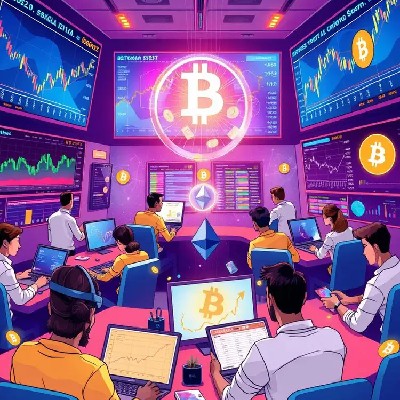Bitget: a 4ª maior corretora do mundo por volume de trading diário!
Participação de mercado do BTC61.43%
Novas listagens na Bitget : Pi Network
BTC/USDT$84015.29 (+2.29%)Índice de Medo e Ganância34(Medo)
Índice da temporada de altcoins:0(Temporada do Bitcoin)
Moedas listadas no pré-mercadoPAWS,WCTFluxo líquido total de ETFs spot de Bitcoin -$60.6M (1D); +$218.9M (7D).Pacote de presente de boas-vindas para novos usuários no valor de 6.200 USDT.Resgatar agora
Opere a qualquer hora e em qualquer lugar com o app da Bitget. Baixe agora
Bitget: a 4ª maior corretora do mundo por volume de trading diário!
Participação de mercado do BTC61.43%
Novas listagens na Bitget : Pi Network
BTC/USDT$84015.29 (+2.29%)Índice de Medo e Ganância34(Medo)
Índice da temporada de altcoins:0(Temporada do Bitcoin)
Moedas listadas no pré-mercadoPAWS,WCTFluxo líquido total de ETFs spot de Bitcoin -$60.6M (1D); +$218.9M (7D).Pacote de presente de boas-vindas para novos usuários no valor de 6.200 USDT.Resgatar agora
Opere a qualquer hora e em qualquer lugar com o app da Bitget. Baixe agora
Bitget: a 4ª maior corretora do mundo por volume de trading diário!
Participação de mercado do BTC61.43%
Novas listagens na Bitget : Pi Network
BTC/USDT$84015.29 (+2.29%)Índice de Medo e Ganância34(Medo)
Índice da temporada de altcoins:0(Temporada do Bitcoin)
Moedas listadas no pré-mercadoPAWS,WCTFluxo líquido total de ETFs spot de Bitcoin -$60.6M (1D); +$218.9M (7D).Pacote de presente de boas-vindas para novos usuários no valor de 6.200 USDT.Resgatar agora
Opere a qualquer hora e em qualquer lugar com o app da Bitget. Baixe agora

Relacionado a moedas
Calculadora de preços
Histórico de preços
Previsão de preço
Análise técnica
Guia de compra de moedas
Categoria de cripto
Calculadora de lucros

Preço de Sleepless AIAI
Listada
Moeda de cotação:
EUR
€0.1450-0.37%1D
Tabela de preços
TradingView
Última atualização em 2025-04-01 12:32:58(UTC+0)
Capitalização de mercado:€42,903,087.16
Capitalização de mercado totalmente diluída:€42,903,087.16
Volume em 24h:€7,480,676.17
Volume em 24h / capitalização de mercado:17.43%
24h high:€0.1481
24h low:€0.1412
All-time high:€2.2
All-time low:€0.1412
Oferta circulante:295,791,680 AI
Oferta total:
1,000,000,000AI
Porcentagem em circulação:29.00%
Oferta máxima:
1,000,000,000AI
Preço em BTC:0.{5}1863 BTC
Preço em ETH:0.{4}8379 ETH
Preço na capitalização de mercado do BTC:
€5,223.97
Preço na capitalização de mercado do ETH:
€706.1
Contratos:
0xBDA0...148d8b2(BNB Smart Chain (BEP20))
Mais
Como é a sua opinião sobre Sleepless AI hoje?
Observação: essas informações servem apenas como referência.
Preço de Sleepless AI hoje
O preço em tempo real do token Sleepless AI é de €0.1450 por (AI / EUR). Sua capitalização de mercado atual é de €42.90M EUR. Seu volume de trading em 24 horas é de €7.48M EUR. O preço de AI em EUR atualizado em tempo real. Sleepless AI variou -0.37% nas últimas 24 horas. Sua oferta circulante atual é de 295,791,680 .
Qual é o preço mais alto do token AI?
AI tem uma máxima histórica de €2.2, registrada em 2024-03-09.
Qual é o preço mais baixo do token AI?
AI tem uma mínima histórica (ATL) de €0.1412, registrada em 2025-04-01.
Previsão de preço do token Sleepless AI
Qual será o preço do token AI em 2026?
Com base no modelo de previsão do desempenho histórico de preços de AI, estima-se que o preço de AI atinja €0.1773 em 2026.
Qual será o preço do token AI em 2031?
Em 2031, espera-se que o preço de AI varie em +5.00%. Ao final de 2031, estima-se que o preço de AI atinja €0.2494, com um ROI acumulado de +73.46%.
Histórico de preços de Sleepless AI (EUR)
O preço de Sleepless AI variou -90.49% no último ano. O preço mais alto de $AI em EUR no último ano foi €1.55 e o preço mais baixo de $AI em EUR no último ano foi €0.1412.
PeríodoVariação de preço (%) Preço mais baixo
Preço mais baixo Preço mais alto
Preço mais alto 
 Preço mais baixo
Preço mais baixo Preço mais alto
Preço mais alto 
24h-0.37%€0.1412€0.1481
7d-19.91%€0.1412€0.1849
30d-34.29%€0.1412€0.2430
90d-71.90%€0.1412€0.7870
1y-90.49%€0.1412€1.55
Todo o período-92.94%€0.1412(2025-04-01, Hoje )€2.2(2024-03-09, 1 anos(s) atrás )
Informações de mercado de Sleepless AI
Sleepless AI - Histórico de capitalização de mercado da empresa
Capitalização de mercado
€42,903,087.16
Capitalização de mercado totalmente diluída
€145,044,949
Classificação de mercado
Sleepless AI - Total de ativos por concentração
Baleias
Investidores
Varejo
Sleepless AI - Endereços por tempo de manutenção
Holders
Cruisers
Traders
Gráfico de preços ao vivo de coinInfo.name (12)

Avaliações de Sleepless AI
Média de avaliações da comunidade
4.4
Este conteúdo é apenas para fins informativos.
AI para a moeda do seu país
1 AI para MXN$3.211 AI para GTQQ1.211 AI para CLP$147.291 AI para HNLL41 AI para UGXSh572.911 AI para ZARR2.871 AI para TNDد.ت0.491 AI para IQDع.د204.961 AI para TWDNT$5.21 AI para RSDдин.16.991 AI para DOP$9.811 AI para MYRRM0.691 AI para GEL₾0.431 AI para UYU$6.61 AI para MADد.م.1.511 AI para AZN₼0.271 AI para OMRر.ع.0.061 AI para KESSh20.221 AI para SEKkr1.571 AI para UAH₴6.48
- 1
- 2
- 3
- 4
- 5
Última atualização em 2025-04-01 12:32:58(UTC+0)
Como comprar Sleepless AI(AI)

Crie sua conta na Bitget gratuitamente
Crie sua conta na Bitget com seu e-mail ou número de celular e escolha uma senha forte para proteger sua conta.

Verifique sua conta
Verifique sua identidade inserindo suas informações pessoais e enviando um documento de identidade válido com foto.

Converter Sleepless AI em AI
Compre Sleepless AI com diversas opções de pagamento na Bitget.
Saiba maisSiga traders de elite e faça Copy Trade de AI.
Depois de criar sua conta na Bitget e comprar tokens USDT ou AI, você também pode começar a seguir traders de elite e fazer copy trades.
Notícias sobre Sleepless AI

ETH ultrapassa 1900 USDT, alta de 5,45% em 24H
Bitget•2025-03-28 23:06

BTC cai abaixo de 84.000 USDT
Bitget•2025-03-28 15:06

A Bitget listará Banana For Scale (BANANAS31) na Área de Inovação e na Área de Memes!
Bitget Announcement•2025-03-26 12:00

A plataforma econômica de IA on-chain da Solana, PioneerAI, está prestes a ser lançada
Bitget•2025-03-21 12:42

A Bitget listará siren (SIREN): participe e ganhe parte do prêmio de 1.649.666 SIREN!
Bitget Announcement•2025-03-21 11:00
Comprar mais
Perguntas frequentes
Qual é o preço atual de Sleepless AI?
O preço em tempo real de Sleepless AI é €0.15 por (AI/EUR), com uma capitalização de mercado atual de €42,903,087.16 EUR. O valor de Sleepless AI sofre oscilações frequentes devido às atividades 24h do mercado de criptomoedas. O preço atual e os dados históricos de Sleepless AI estão disponíveis na Bitget.
Qual é o volume de trading em 24 horas de Sleepless AI?
Nas últimas 24 horas, o volume de trading de Sleepless AI foi €7.48M.
Qual é o recorde histórico de Sleepless AI?
A máxima histórica de Sleepless AI é €2.2. Essa máxima histórica é o preço mais alto para Sleepless AI desde que foi lançado.
Posso comprar Sleepless AI na Bitget?
Sim, atualmente, Sleepless AI está disponível na Bitget. Para informações detalhadas, confira nosso guia Como comprar sleepless-ai .
É possível obter lucros constantes ao investir em Sleepless AI?
Claro, a Bitget fornece uma plataforma de trading estratégico com robôs de trading para automatizar suas operações e aumentar seus lucros.
Onde posso comprar Sleepless AI com a menor taxa?
Temos o prazer de anunciar que a plataforma de trading estratégico já está disponível na corretora da Bitget. A Bitget é líder de mercado no que diz respeito a taxas de trading e profundidade, o que garante investimentos lucrativos para os traders.
Onde posso comprar Sleepless AI (AI)?
Seção de vídeos: verificação e operações rápidas

Como concluir a verificação de identidade na Bitget e se proteger contra golpes
1. Faça login na sua conta Bitget.
2. Se você for novo na Bitget, assista ao nosso tutorial sobre como criar uma conta.
3. Passe o mouse sobre o ícone do seu perfil, clique em "Não verificado" e clique em "Verificar".
4. Escolha seu país ou região emissora, o tipo de documento de identidade e siga as instruções.
5. Selecione como prefere concluir sua verificação: pelo app ou computador.
6. Insira seus dados, envie uma cópia do seu documento de identidade e tire uma selfie.
7. Envie sua solicitação e pronto. Verificação de identidade concluída!
Os investimentos em criptomoedas, incluindo a compra de Sleepless AI na Bitget, estão sujeitos a risco de mercado. A Bitget fornece maneiras fáceis e convenientes para você comprar Sleepless AI. Fazemos o possível para informar totalmente nossos usuários sobre cada criptomoeda que oferecemos na corretora. No entanto, não somos responsáveis pelos resultados que possam advir da sua compra Sleepless AI. Esta página e qualquer informação incluída não são um endosso de investimento ou a nenhuma criptomoeda em particular.
Bitget Insights

Crypto_inside
3h
Day trading ❌ Swing trading. 🧐😵💫
Day trading and swing trading are two popular trading strategies used in financial markets. While both strategies aim to profit from market fluctuations, they differ in their approach, time frame, and risk management.
Day Trading:
1. Intra-day trading: Day traders buy and sell securities within a single trading day.
2. Closing positions before market close: Day traders close all positions before the market closes to avoid overnight risks.
3. Frequent trading: Day traders make multiple trades throughout the day.
4. Technical analysis: Day traders rely heavily on technical analysis, using charts and indicators to identify trading opportunities.
5. Risk management: Day traders use stop-loss orders and position sizing to manage risk.
Swing Trading:
1. Short-term trading: Swing traders hold positions for a shorter period than investors, typically from a few days to a few weeks.
2. Holding positions overnight: Swing traders may hold positions overnight, exposing themselves to overnight risks.
3. Less frequent trading: Swing traders make fewer trades than day traders, as they hold positions for longer periods.
4. Combination of technical and fundamental analysis: Swing traders use a combination of technical and fundamental analysis to identify trading opportunities.
5. Risk management: Swing traders use stop-loss orders, position sizing, and risk-reward ratios to manage risk.
Key Differences:
1. Time frame: Day traders hold positions for minutes or hours, while swing traders hold positions for days or weeks.
2. Trading frequency: Day traders make multiple trades throughout the day, while swing traders make fewer trades.
3. Risk management: Day traders focus on managing risk through quick trade execution and tight stop-loss orders, while swing traders use a combination of risk management strategies.
4. Analysis: Day traders rely heavily on technical analysis, while swing traders use a combination of technical and fundamental analysis.
Choosing Between Day Trading and Swing Trading:
1. Trading style: Day trading suits traders who can dedicate several hours a day to monitoring markets and making trades. Swing trading suits traders who prefer to hold positions for longer periods.
2. Risk tolerance: Day trading involves higher risk due to the fast-paced nature of the markets. Swing trading involves lower risk, as positions are held for longer periods.
3. Market analysis: Day traders rely on technical analysis, while swing traders use a combination of technical and fundamental analysis.
4. Time commitment: Day trading requires a significant time commitment, while swing trading requires less time.
Thank you...🙂
$BTC $ETH $SOL $PI $AI $XRP $DOGE $SHIB $BONK $COQ $CATS $BGB $BNB $U2U $WUF $WHY $SUNDOG $PARTI $CEC $BLUR
SUNDOG0.00%
BTC+1.77%

Crypto_inside
3h
What is 'Position trading'..🤔🤔??
Position trading is a long-term trading strategy that involves holding a position in a security for an extended period, typically weeks, months, or even years. This approach focuses on capturing significant price movements and trends, rather than trying to time the market or make quick profits.
Key Characteristics:
1. Long-term focus: Position traders hold positions for an extended period, riding out market fluctuations.
2. Trend following: Position traders aim to identify and follow long-term trends in the market.
3. Fundamental analysis: Position traders often rely on fundamental analysis, examining a company's financials, management, and industry trends.
4. Risk management: Position traders must manage risk carefully, as large price movements can result in significant losses.
Position Trading Strategies:
1. Trend identification: Position traders use technical indicators and chart patterns to identify long-term trends.
2. Breakout trading: Position traders buy or sell when a security breaks out of a established trading range.
3. Mean reversion: Position traders bet on prices reverting to their historical means.
Advantages:
1. Reduced transaction costs: Position traders incur lower transaction costs due to fewer trades.
2. Less emotional stress: Position traders are less affected by short-term market volatility.
3. *Potential for significant gains*: Position traders can capture significant price movements and trends.
Disadvantages:
1. Market risk: Position traders are exposed to market risk, as large price movements can result in significant losses.
2. Opportunity cost: Position traders may miss out on other investment opportunities while holding a long-term position.
3. Requires patience and discipline: Position traders must be patient and disciplined, as it can take time for a trade to develop.
Position Trading vs. Day Trading:
1. Trade duration: Position traders hold positions for weeks, months, or years, while day traders close their positions within a single trading day.
2. Trade frequency: Position traders make fewer trades, while day traders make multiple trades throughout the day.
3. Risk management: Position traders focus on managing risk through position sizing and stop-loss orders, while day traders focus on managing risk through quick trade execution and tight stop-loss orders.
Position trading requires a unique combination of fundamental analysis, technical analysis, and risk management. While it can be a profitable strategy, it's essential to carefully consider the risks and challenges involved.
Thank you...🙂
$BTC $ETH $SOL $PI $AI $XRP $BGB $BNB $DOGE $SHIB $BONK $FLOKI $U2U $WUF $ORDER $SUNDOG $TRX $WHY
SUNDOG0.00%
BTC+1.77%

Crypto_inside
3h
What is Scalping...🤔🤔??
Scalping is a trading strategy that involves making multiple small trades in a short period, typically seconds or minutes, to take advantage of small price movements. The goal of scalping is to accumulate small profits from each trade, which can add up to significant gains over time.
Key Characteristics:
1. Short-term focus: Scalping involves holding trades for a very short period.
2. High-frequency trading: Scalpers make multiple trades in rapid succession.
3. Small profit targets: Scalpers aim to make small profits from each trade.
4. Risk management: Scalpers must manage risk carefully to avoid significant losses.
Scalping Strategies:
1. Trend following: Scalpers follow the trend, making trades in the direction of the market momentum.
2. Range trading: Scalpers buy and sell within a specific price range, taking advantage of oscillations.
3. Mean reversion: Scalpers bet on prices reverting to their historical means.
Tools and Techniques:
1. Technical analysis: Scalpers use technical indicators, such as moving averages and RSI, to identify trading opportunities.
2. Chart patterns: Scalpers recognize chart patterns, such as triangles and wedges, to anticipate price movements.
3. Order flow analysis: Scalpers analyze order flow to gauge market sentiment and identify potential trading opportunities.
Risks and Challenges:
1. Market volatility: Scalping involves trading in volatile markets, which can result in significant losses.
2. Commissions and fees: Scalpers incur high transaction costs due to frequent trading.
3. Emotional stress: Scalping can be emotionally demanding, requiring intense focus and quick decision-making.
Scalping vs. Day Trading:
1. Trade duration: Scalping involves holding trades for seconds or minutes, while day trading involves holding trades for hours or until the market closes.
2. Trade frequency: Scalpers make multiple trades in rapid succession, while day traders typically make fewer trades.
Scalping requires a unique combination of technical analysis, risk management, and mental discipline. While it can be a profitable strategy, it's essential to carefully consider the risks and challenges involved.
Thank you...🙂
$BTC $ETH $SOL $PI $AI $XRP $DOGE $SHIB $BONK $COQ $U2U $WUF $ADA $WHY $SUNDOG $PARTI $CATS
SUNDOG0.00%
BTC+1.77%

Crypto_inside
5h
What is IQ..🤔🤔??
Intelligence Quotient (IQ) is a score derived from standardized tests designed to measure human intelligence. IQ tests assess various cognitive abilities, such as:
Components of IQ Tests:
1. Verbal Comprehension: Measures ability to understand and use language.
2. Perceptual Reasoning: Assesses ability to reason, form concepts, and solve problems.
3. Working Memory: Evaluates ability to hold and manipulate information in short-term memory.
4. Processing Speed: Measures ability to quickly and accurately process visual information.
IQ Score Interpretation:
1. Average IQ: 85-115 (68% of population)
2. Above Average IQ: 116-130 (16% of population)
3. Gifted IQ: 131-145 (2% of population)
4. Highly Gifted IQ: 146-160 (0.1% of population)
5. Profoundly Gifted IQ: 161-175 (0.01% of population)
Criticisms and Limitations of IQ Tests:
1. Cultural Bias: IQ tests may favor certain cultural or socioeconomic groups.
2. Narrow Scope: IQ tests only measure specific aspects of intelligence.
3. Context-Dependent: IQ scores can be influenced by environmental factors.
4. Oversimplification: IQ scores can oversimplify complex cognitive abilities.
Types of Intelligence:
1. Fluid Intelligence: Ability to reason, think abstractly, and solve problems.
2. Crystallized Intelligence: Ability to use learned knowledge and experience.
3. Emotional Intelligence: Ability to recognize and understand emotions.
Notable Theories and Models:
1. Gardner's Multiple Intelligences: Proposes multiple types of intelligence, such as linguistic, spatial, and bodily-kinesthetic.
2. Sternberg's Triarchic Theory: Suggests three components of intelligence: analytical, creative, and practical.
IQ tests provide a limited snapshot of cognitive abilities and should not be considered the sole measure of intelligence or potential.
Thank you...🙂
$BTC $ETH $SOL $PI $AI $XRP $BGB $BNB $ONDO $DOGE $SHIB $BONK $FLOKI $U2U $WUF $PARTI $WHY $SUNDOG
SUNDOG0.00%
BTC+1.77%

Crypto_inside
6h
Machine learning ❌ Traditional learning. 🧐😵💫
Machine learning and traditional learning are two distinct approaches to learning and problem-solving.
Traditional Learning:
1. Rule-based: Traditional learning involves explicit programming and rule-based systems.
2. Human expertise: Traditional learning relies on human expertise and manual feature engineering.
3. Fixed models: Traditional learning uses fixed models that are not updated automatically.
Machine Learning:
1. Data-driven: Machine learning involves learning from data and improving over time.
2. Algorithmic: Machine learning relies on algorithms that can learn from data and make predictions.
3. Adaptive models: Machine learning uses adaptive models that can update automatically based on new data.
Key Differences:
1. Learning style: Traditional learning is rule-based, while machine learning is data-driven.
2. Scalability: Machine learning can handle large datasets and complex problems, while traditional learning is limited by human expertise.
3. Accuracy: Machine learning can achieve higher accuracy than traditional learning, especially in complex domains.
Advantages of Machine Learning:
1. Improved accuracy: Machine learning can achieve higher accuracy than traditional learning.
2. Increased efficiency: Machine learning can automate many tasks, freeing up human experts for more complex tasks.
3. Scalability: Machine learning can handle large datasets and complex problems.
Disadvantages of Machine Learning:
1. Data quality: Machine learning requires high-quality data to learn effectively.
2. Interpretability: Machine learning models can be difficult to interpret and understand.
3. Bias: Machine learning models can perpetuate biases present in the training data.
When to Use Machine Learning:
1. Complex problems: Machine learning is well-suited for complex problems that require pattern recognition and prediction.
2. Large datasets: Machine learning can handle large datasets and identify trends and patterns.
3. Automating tasks: Machine learning can automate many tasks, freeing up human experts for more complex tasks.
When to Use Traditional Learning:
1. Simple problems: Traditional learning is well-suited for simple problems that require explicit programming and rule-based systems.
2. Small datasets: Traditional learning is suitable for small datasets where machine learning may not be effective.
3. Human expertise: Traditional learning relies on human expertise and manual feature engineering, making it suitable for domains where human expertise is essential.
Thank you...🙂
$BTC $ETH $SOL $PI $AI $XAI $BGB $BNB $DOGE $DOGS $SHIB $BONK $MEME $XRP $ADA $U2U $WUF $PARTI $WHY
BTC+1.77%
BGB+2.48%
Ativos relacionados
Criptomoedas populares
Uma seleção das 8 principais criptomoedas por valor de mercado.
Adicionado recentemente.
As criptomoedas adicionadas mais recentemente.
Capitalização de mercado comparável
Entre todos os ativos da Bitget, esses 8 são os mais próximos do Sleepless AI em valor de mercado.


































Dados sociais de Sleepless AI
Nas últimas 24 horas, a pontuação do sentimento dos usuários de redes sociais para o token Sleepless AI foi 3.5, e o sentimento nas redes sociais em relação à tendência de preço do token Sleepless AI foi Em alta. A pontuação geral do token Sleepless AI nas redes sociais foi de 85,946. Sua posição no ranking de criptomoedas é 87.
De acordo com a LunarCrush, nas últimas 24 horas, as criptomoedas foram mencionadas nas redes sociais um total de 1,058,120 vezes. O token Sleepless AI foi mencionado com uma frequência de 0.01%, classificando-se em 237 no ranking de criptomoedas.
Nas últimas 24 horas, 33 usuários únicos mencionaram o token Sleepless AI. O total de menções ao token Sleepless AI foi de 95. No entanto, em comparação com o período de 24 horas anterior, o número de usuários únicos diminuir 47%, e o número total de menções diminuir 32%.
No Twitter, houve um total de 4 tweets mencionando Sleepless AI nas últimas 24 horas. Entre eles, 75% estão otimistas em relação ao token Sleepless AI, 25% estão pessimistas em relação ao token Sleepless AI e 0% estão neutros em relação ao token Sleepless AI.
No Reddit, houve 1 postagens mencionando Sleepless AI nas últimas 24 horas. Em comparação com o período de 24 horas anterior, o número de menções diminuir em 0%.
Visão geral das redes sociais
3.5